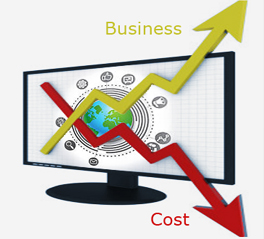
E-commerce has continued on a strong growth path since it became a viable business channel in mid-nineties. Approaching fifteen years, the rate of its growth is showing no signs of slowing down. According to eMarketer.com, US retail e-commerce sales are projected to grow by 11.1% to $200.6 Billion[1] in 2010. Combine this information with increase in internet usage from 361 million to 1.67 Billion users between 2000 and 2009 at a CAGR of 18.5%[2], it can be concluded that internet as marketing and e-commerce channel continues to hold tremendous potential.
Any growth area will attract attention from companies hungry for more revenues and internet is no different. As the competition heats up, the ability to rank higher in organic search engine results requires more than just a good website. Similarly, another growing area is social media marketing. According to “Best-in-Class Companies” worldwide, 63% of the surveyed companies plan to increase social media marketing spending anywhere from 1% to 25%[3].
Let’s first look at four fundamental stages in developing an online marketing strategy:
Channel
Creating a website without creating a channel is like building a shop in the middle of a jungle. No one knows it exists, so it won’t attract many, if any, visitors. Therefore, efforts such as Search Engine Optimization (SEO), Social Media Marketing (SMM), blogging, and Pay-Per-Click (PPC) to name a few, help to create that channel through which potential customers are directed to the website. The goal is to drive relevant traffic.
Hold
A successful channel funnels visitors to the website but if the visitor bounces off main or landing page, then not much has been achieved. The visitor must find the landing page relevant and/or attractive enough to explore the website. Therefore, landing page in particular and website in general must cater to what the visitor is looking for. In short, the landing page must effectively convey the value proposition.
Stay
Once a user visits the website, the goal should be to encourage the user to stay. The website should be well structured so the user can easily find the products and/or services offered. As a rule of thumb, the visitor should visit at least three pages for him or her to get a concrete idea of what the company is about.
Yield
Last but not least, the visitor must send in an inquiry or make contact via phone, email, etc. thus, generating a lead.
While larger organizations have the flexibility to allocate their marketing dollars where required, the small businesses (in $1 – $20 million range) find cost as the main hurdle in devising and implementing a sustained online marketing strategy. One way to address the cost factor is by outsourcing the IM tasks to a reliable outsourcing partner. Almost 80 – 90% of IM tasks can be performed remotely. As a check, you may ask your partner to devise your IM strategy and how it will be implemented. This will help you understand their capabilities and experience. Once IM strategy has been devised and implemented, a good number of the tasks become repetitive in nature thus making those suitable for outsourcing.
Another important factor is your outsourcing partner’s ability to collaborate and stay up-to-date with ever changing IM area. Google and other major search engines change the search criteria when they deem it necessary. IM falls more under Knowledge Process Outsourcing (KPO), therefore, your partner must have depth in its skill set and the intellectual capacity to adapt and keep learning this dynamic area.
Successful outsourcing of your IM activities will not only create and sharpen your competitive advantage but will also contribute to lowering the cost structure – an important goal given the current economy.
[2] http://www.internetworldstats.com/stats.htm
[3] Aberdeen Group, “The ROI on Social Media Marketing: Why it Pays To Drive Word of Mouth,” March 11, 2009


 Mar 30 2010
Mar 30 2010  Posted by: admin
Posted by: admin  Posted in
Posted in